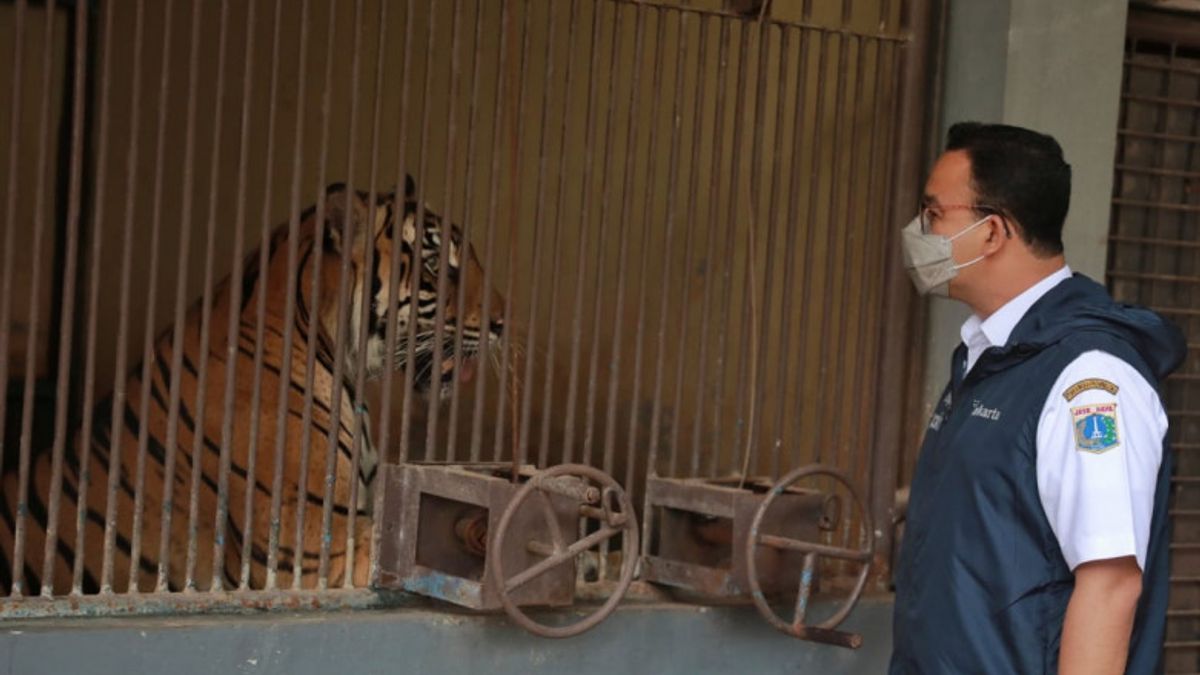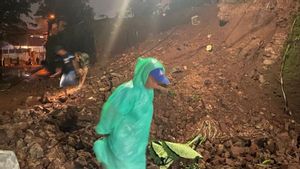JAKARTA - The news of the exposure of two Sumatran tigers in the Ragunan Wildlife Park (TMR) announced by the Governor of DKI Jakarta Anies Baswedan may be the most unique and rare information that has colored the news line.
The two Sumatran tigers, named Tino and Hari, were reported to have been confirmed as self-isolated patients at the Ragunan Wildlife Park after undergoing a COVID-19 examination, the results of which were released by the Biotechnology Laboratory of the Center for Primate Animal Studies, Bogor Agricultural University.
Fortunately, Tino and Hari are no longer exposed to the SARS-CoV-2 virus and have been declared cured although they are still being monitored under the DKI Jakarta City Parks and Forests Service.
Actually, cases of exposed animals have been common since the COVID-19 pandemic hit the world, especially for pets such as cats and dogs.
Launching Antara, Sunday, August 1, globally, the first report of exposure to animals by the SARS-CoV-2 virus was found at the Kentucky Zoo, United States on December 11, 2020.
Three snow leopards were confirmed positive for COVID-19 after undergoing testing when one of them experienced the same symptoms as humans exposed to COVID-19.
Some of the symptoms experienced by the leopard were also experienced by Tino and Hari, who are now 9 and 12 years old, respectively.
Some of them experience symptoms of shortness of breath, sneezing, runny nose, and no appetite.
Other symptoms that may appear in animals exposed to COVID-19, according to the Center for Diseases Control and Prevention (CDC), include fever, cough, weakness, eye problems, vomiting, and diarrhea.
So how can animals get COVID-19?The CDC, which acts as the disease control agency of the US Department of Health, said that studies that have been conducted have proven that animals are exposed to the SARS-CoV-2 virus due to close contact with humans who are positive for COVID-19.
Close contact is meant to interact directly, share air circulation in the same room, so as not to maintain a distance so that the animals are eventually exposed to COVID-19.
In studies conducted globally, pets are animals that have a high potential for exposure to COVID-19.
Citing Scientific American, a study led by veterinarian Sarah Hamer of A&M University in Texas showed cats had higher levels of exposure than dogs.
Cats that have been exposed to the SARS-CoV-2 virus also have a great potential to infect other cats.
In addition to pets, animals in zoos and the wild that are included in big cat species (lions, tigers, leopards, cheetahs, jaguars), bears, primates, or mammals are also potentially exposed to COVID-19.
However, there has not been any exposure to livestock such as chickens, ducks and cows for COVID-19 cases.
arta, 01/8 (ANTARA) - The news of the exposure of two Sumatran tigers in the Ragunan Wildlife Park (TMR) announced by the Governor of DKI Jakarta Anies Baswedan may be the most unique and rare information that has colored the news line starting this August 2021.
The two Sumatran tigers, named Tino and Hari, are reported to have been confirmed as self-isolating patients at the Ragunan Wildlife Park after undergoing a COVID-19 examination, the results of which were released by the Biotechnology Laboratory of the Center for Primate Animal Studies, Bogor Agricultural University.
Fortunately, Tino and Hari are no longer exposed to the SARS-CoV-2 virus and have been declared cured although they are still being monitored under the DKI Jakarta City Parks and Forests Service.
Actually, cases of exposed animals have been common since the COVID-19 pandemic hit the world, especially for pets such as cats and dogs.
Globally, the first report of animal exposure to the SARS-CoV-2 virus was found at the Kentucky Zoo, United States on December 11, 2020.
Three snow leopards were confirmed positive for COVID-19 after undergoing testing when one of them experienced the same symptoms as humans exposed to COVID-19.
Some of the symptoms experienced by the leopard were also experienced by Tino and Hari, who are now 9 years old and 12 years old, respectively.
Some of them experience symptoms of shortness of breath, sneezing, runny nose, and no appetite.
Other symptoms that may appear in animals exposed to COVID-19, according to the Center for Diseases Control and Prevention (CDC), include fever, cough, weakness, eye problems, vomiting, and diarrhea.
So how can animals get COVID-19?
The CDC, which acts as the disease control agency of the US Department of Health, said in the studies that had been done it was proven that animals were exposed to the SARS-CoV-2 virus because of close contact with humans who were positive for COVID-19.
Close contact is meant to interact directly, share air circulation in the same room, so as not to maintain a distance so that the animals are eventually exposed to COVID-19.
In studies conducted globally, pets are animals that have a high potential for exposure to COVID-19.
Citing Scientific American, a study led by veterinarian Sarah Hamer of A&M University in Texas showed cats had higher levels of exposure than dogs.
Cats that have been exposed to the SARS-CoV-2 virus also have a great potential to infect other cats.
In addition to pets, animals in zoos and the wild that are included in big cat species (lions, tigers, leopards, cheetahs, jaguars), bears, primates, or mammals are also potentially exposed to COVID-19.
However, there has not been any exposure to livestock such as chickens, ducks and cows for COVID-19 cases.
PreventionEven though in Indonesia there has only been one report of an animal being exposed to COVID-19 and it made us know that even animals can be infected with the SARS-CoV-2 virus, of course preventive activities must still be carried out.
In the case of Tino and Hari, close contact tracing is one way to avoid exposure to the virus, which has a high transmission rate, to other animals in the Ragunan Wildlife Park.
In the US too, the same thing was also done so that transmission between animals did not occur massively and could be controlled and cured.
Then how to prevent pets aka fur children at home to stay safe so they are not exposed to COVID-19?
There are two ways that can be done, first from the human side as animal owners.
Humans as animal owners must ensure that all family members who meet the requirements must get the COVID-19 vaccine.
As much as possible, do not allow pets to come into contact with people who have not received the COVID-19 vaccine.
The application of a healthy lifestyle such as keeping the cage or house clean for pets, and always washing hands must be a priority to prevent the potential for transmission of SARS-CoV-2.
Launching a statement from the United States Department of Agriculture (USDA), if a pet owner becomes a COVID-19 patient, then make sure you self-isolate not only other humans but also your pets.
Do not sleep together let alone kiss your pet when you are positive for COVID-19.
You are allowed to come into contact with your pet again when it has recovered and is no longer experiencing symptoms.
The second prevention is to carry out early detection of pets.
If the animal is showing symptoms of fever, cough, runny nose, difficulty breathing, weakness, sneezing, runny nose, infected eyes, vomiting and diarrhea then all you need to do is prepare an isolation room for your pet.
Just as humans undergo self-isolation, animals with COVID-19 symptoms must also be isolated.
Not only from humans, but also from other pets if you have more than one pet.
Separate their places to eat, drink, bed, toys, and necklaces when cleaning with other items.
When disposing of animal waste with COVID-19 symptoms, it is a good idea to use washable or disposable gloves to maintain hygiene and body hygiene.
The CDC does not recommend that pet owners let their animals go for walks in the park or roam the neighborhood while experiencing these symptoms.
As much as possible, immediately contact the nearest veterinarian for further treatment, including treatment.
Until now, specifically for COVID-19 testing for animals, it is not yet available in Indonesia, but reflecting on the handling abroad, the average COVID-19 case in animals can only be tested by veterinarians who have communicated directly with the health department or the health department from local government.
Therefore, it is not recommended to carry out independent testing using human COVID-19 test kits on animals.
Only one thing that is different for animals for handling when they have symptoms of COVID-19 is that they do not need to wear masks.
This is because animals have a low potential to transmit the SARS-CoV-2 virus to humans directly, so you don't need to put a mask on your animal when experiencing symptoms of COVID-19.
Even though in Indonesia there is only one case, of course prevention is still better than cure, so that your pet remains protected and gets optimal health.
The English, Chinese, Japanese, Arabic, and French versions are automatically generated by the AI. So there may still be inaccuracies in translating, please always see Indonesian as our main language. (system supported by DigitalSiber.id)













